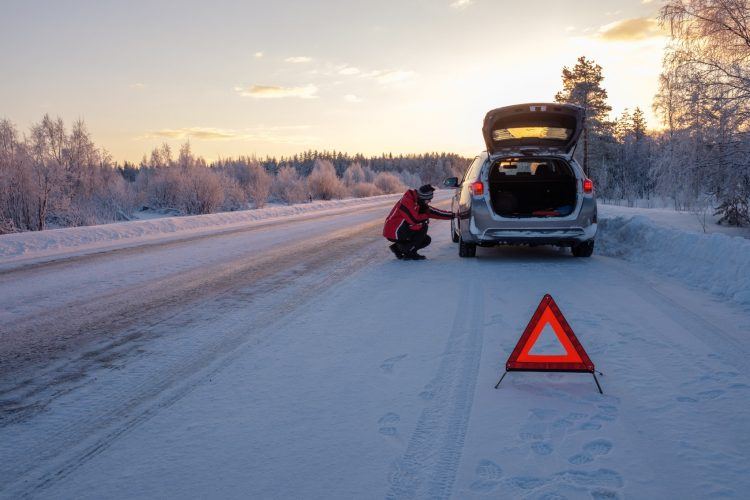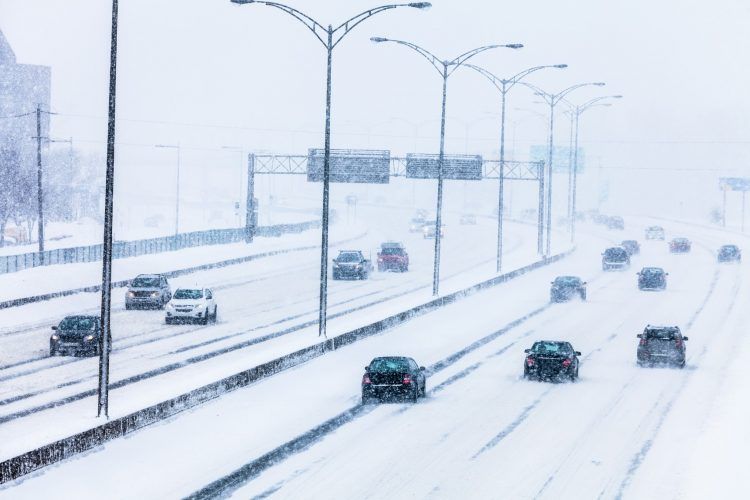This winter driving guide includes:
- How to respond during an emergency.
- Driving tips that will help keep you and your family safe.
- A comprehensive checklist for getting your vehicle “winterized.”
- Seven simple DIY maintenance items to watch during the winter.
- What to place in your emergency kit, including something we all overlook.
- How states utilize the latest technology to help keep you safe when traveling.
Affiliate Disclosure: As an Amazon Associate, Automoblog earns from qualifying purchases, including some of the items featured in this winter driving guide. These commissions come to us at no additional cost to you.
Winter Driving 101: The Complete Guide
With this guide, you can better prepare your vehicle (and yourself) to tackle snow and ice more confidently. One thing that may come as a surprise is the actual number of accidents during the snowy season. Contrary to popular belief, there are not more crashes during the winter months.
“But those we see tend to be more serious,” explained Maureen Vogel, spokeswoman for the National Safety Council. “Often, drivers do not realize how much they need to slow down when the weather is bad. Many tend to drive too fast for the conditions, which can lead to unnecessary crashes.”
This winter guide consists of three main parts: getting your vehicle ready, tips for driving in the snow, and what to do during an emergency. We will also look at what to place in your emergency kit and provide links to additional resources from other safety experts.
Vehicle Safety Checklist: 4 Essential Points
Let’s start this winter driving guide by examining the condition of your vehicle. It’s best to do this before the snow falls or before taking any long trip this winter.
#1. When Was Your Last Service?
Start by making an appointment with your local mechanic or dealership for routine service, usually an oil change and a tire rotation. During that process, your car will undergo a multi-point inspection. These inspections should be thorough and encompass the majority of your vehicle. The mechanic will let you know what (if anything) needs to be replaced after the inspection.
When it comes to replacing parts, always prioritize safety items first. For example, brakes, tires, and wheel bearings can directly impact safety if left unchecked. Ask your mechanic to go through the multi-point inspection and explain each item if necessary (at reputable shops and dealerships, they will be happy to do this).
#2. Check For Existing Safety Recalls
Go to the NHTSA Safety Issues & Recalls page to check if your vehicle has any outstanding safety recalls. Enter the VIN number or the make and model of your car and go from there. Safety recalls are replaced for free at the dealership because the manufacturer covers them.
#3. Check Tire Pressures
Did you know tire pressures drop an average of two PSI for every 10-degree drop in ambient temperature? Check your owner’s manual for the recommended range of tire inflation pressures. Vehicles today also have the recommended tire pressures printed in a chart-like box inside the driver’s side door jamb.
Always check the tire pressure before traveling long distances. Most cars today are equipped with a Tire Pressure Monitoring System, or TPMS for short. If a tire drops too low, you will receive a warning light on your dashboard.
Consider keeping a portable inflator in your emergency kit in case you get a low tire. We like the Slime 12V inflator, which is what we currently have in our winter kit.
#4. Does Your Vehicle Need New Shoes?
While having the correct tire pressure is essential, it will mean little if your tires are at the end of their useable life. The more “depth” your tires have, the better the traction. As a general rule of thumb, replace your tires when the tread depth drops to 4/32″. Although all-season tires are common on vehicles today, investing in a set of snow tires has benefits.
“If temperatures are generally above 15°F and there is only light to moderate snowfall, all-season tires may be adequate,” said Michael Calkins, Manager of Technical Services at the American Automobile Association or AAA. “However, if you live where temperatures are frequently below 15°F, and there are regular storms that deliver several inches of snow, then snow tires will provide definite traction, handling, and safety benefits.”
Snow tires are manufactured with softer compounds that provide a better grip in freezing temperatures. Snow tires also have aggressive tread designs with various biting edges or sipes to offer greater traction. In some cases, snow tires will come with metal studs for increased traction over and through deep snow.
“If your car slips and slides on snowy or icy pavement, or if it’s hard to accelerate and brake without spinning or locking the wheels, that’s when you want to consider snow tires,” Calkins explained. “Or if your car doesn’t want to track smoothly through corners without losing traction at the front or rear, snow tires will be of huge benefit in this regard.”
Based on our research, Michelin, Bridgestone, Dunlop, General, and Continental are among the best tires for snow and ice. Cooper, Kumho, Hankook, and Toyo are among the best cheap tires if you are shopping on a budget.
“Traction from your tires is your first and last line of defense,” added Brandon Grade, Service Advisor at Findlay Toyota in Las Vegas, Nevada. “Traction control systems can only do so much when the mechanical grip has been removed.”

7 Simple DIY Items for Winter Driving
Even if your car and tires are in relatively good shape, there are still a few DIY maintenance items to check during the winter. If you would like more info to accompany the list below, see this handy guide we put together with Advance Auto Parts.
#1. Check The Battery
Batteries lose their charge faster when they are cold, making it harder to crank the motor during the winter season. If you see cracks or damage on the battery casing, replace it immediately. You can also use a multimeter to check the voltage of the battery. If the reading falls below 12.40 volts to 12.75 volts, it may be time for a new battery.
Picking out the correct battery can be surprisingly tricky, and there are a few essential things to consider. Here is a helpful guide that goes over the best car batteries for cold weather.
#2. Check All Exterior Lights
This includes the headlights, taillights, signal markers, and hazard lights. If one or more of the bulbs are defective, replace them as soon as possible.
#3. Check The Coolant Reservoir
The coolant primarily lubricates all the metal and aluminum parts in the cooling system. This includes the radiator, water pump, and other critical internal components. Coolant or antifreeze will also prevent the liquid from hardening or freezing inside the cooling system.
One of the best ways to keep your cooling system in good working order is to consider flushing it, especially if you have an older vehicle and cannot remember the last time you did it. As for how often you should flush your coolant, it’s best to consult your local mechanic or the owner’s manual.
#4. Wiper Blades Are Important
As a general maintenance rule, you don’t need to wait for the windshield to get streaky before replacing the wiper blades. If you cannot remember the last time you changed your wiper blades, go ahead and do it now.
While there are lower-cost options, we recommend spending a little extra for a higher-quality set of Rain-X blades. We have had cheaper blades in the past, but they tend to wear out faster and are less durable than the Rain-X ones.
#5. Top Off The Washer Fluid
You will use a lot of windshield wiper fluid during the winter! It is a good idea to check the reservoir every time you stop for gas. Keep a reserve jug (or two) in your trunk. We recommend an all-season solution that will work well as a de-icer in the winter and for bugs during the summer.
#6. Fill Up Often
We recommend keeping your gas tank at least a third full when driving in the winter. If the weather is really bad, the tank should be at least half full. If you find yourself stranded, a full tank means the engine can run, and you can stay warm. Of course, this is also insurance against running out of gas on an icy, frozen road.
#7. Change The Floor Mats
Rubberized floor mats are ideal for winter driving because they can trap dirt, snow, and slush without staining the carpet. Rubber floor mats are also much easier to clean. Make sure you fit them correctly, so the mats do not interfere with the gas and brake pedal.
Over the years, we have had good luck with WeatherTech floor liners and Gledring mats. Other popular brands include Husky Liners and Lloyd NorthRidge.

Prepare An Emergency Kit (With An Atlas)
In a study conducted by law firm Siegfried & Jensen, 62 percent said they feel prepared in the event of a breakdown. However, that same study found people carry just four of the eight emergency items recommended by DMV.org.
“This research goes to show how gravely under-prepared drivers are for accidents on the road,” said Ned Siegfried, President of Siegfried & Jensen. “This misplaced confidence suggests there isn’t enough being done to educate drivers about how to get their vehicles ready.”
Siegfried & Jensen found that less than a quarter of Americans have paper maps while only 11 percent have a sat nav, suggesting drivers rely primarily on smartphones for directions. Although it may seem outdated, having an inexpensive road atlas handy is a good idea, just in case your phone loses signal or the battery dies.
Your emergency kit should include:
- Flashlight
- Jumper Cables
- Salt or Kitty Litter
- Matches or Lighter
- Flares or Glow Sticks
- Spare Phone Charger
- Small Shovel & Scraper
- Spare Clothing & Blankets
- Food, Bottled Water & Medication
You can also find pre-made winter emergency car kits for sale on Amazon or other stores.
Instead of jumper cables, you can opt for a portable jump starter (we currently have this Shell 1200A unit in our emergency kit). Portable jump starters are nice because they can work if you are by yourself, unlike jumper cables. They also include things like a flashlight with an SOS signal and an integrated charging bank for your phone. In addition to the Shell 1200A jump starter, here are some other portable jump starters we recommend.

Driving In Snow & Ice: 4 Things To Consider
Now that your vehicle is in tip-top shape and your emergency kit and atlas are packed, here are five tips to help you safely arrive at your destination.
#1. Obey The Speed Limit
Driving at high speeds, especially on slippery roads, is dangerous.
“The majority of traffic crashes in the winter can be attributed to driving too fast for the conditions of the roadway,” said Jim Flegel, Special First Lieutenant, Michigan State Police. “Drivers must obey the basic speed laws and must operate their vehicle at a careful and prudent speed, taking into account the road and weather conditions at all times.”
Always keep a safe distance from the other vehicle in front of you too.
“By adhering to the basic speed law, the driver will be able to properly maintain control of their vehicle and will be able to stop within the assured clear distance ahead,” Flegel added. “The only compensation that will work when driving on slippery roads is to slow down and increase your following distance.”
#2. Avoid Distracted Driving
Driving over slippery or icy surfaces is hard enough, but doing it while distracted severely increases your chances of an accident. No matter how good you think you are behind the wheel, distracted driving can seriously injure or kill you, your family, and other road users. Never text, call, or use a mobile device when you drive. Even a split second of distraction can mean the difference between life and death.
#3. Always Drive Sober
Alcohol and other drugs significantly impair your reaction time and judgment. Winter holidays like Christmas and New Year’s always see a spike in drunk driving accidents. If you are headed out for the night, always designate a sober driver beforehand.
#4. Plan Ahead
Even if the weather conditions are generally calm from where you are, it might not be the same at your destination. In Michigan, travelers can see the location of plow trucks in real-time across the state. The trucks even have onboard cameras so you can see what the plow operator sees.
Pennsylvania’s Where’s My Plow? and North Dakota’s Track-A-Plow are similar programs. North Dakota Department of Transportation Director Tom Sorel believes we should use the advancements in technology to our advantage.
“This is one more piece of information that travelers can use to see what is happening on the highways and make more informed decisions when making travel plans,” he said.
Check your home state’s department of transportation website to see if a similar program exists in your area.
“Be a good defensive driver so you can continuously scan for other motorists losing control and crossing the centerline,” Flegel added. “Check the weather report, leave early if necessary, and let others know your route and anticipated arrival time.”

What To Do During An Emergency
If something bad happens, do not panic. Check if you or your passengers are injured, then follow the Steer It, Clear It rule. “If you are not injured, and the vehicle is drivable, immediately move the vehicle from the traveled portion of the roadway to the shoulder or other safe location,” Flegel said.
The next thing is to call 911 or roadside assistance.
“Take good note of your location, including the mile marker if you’re on the highway, to ensure they can easily find you,” Vogel said.
Other important things to remember immediately after an accident:
- Stay inside your vehicle with the seat belt securely fastened.
- Activate your four-way emergency flashers to warn others.
- If you must leave your vehicle, be aware of passing traffic.
- Walk directly to a safe location away from the traveled portion of the roadway.
- Call 911 and report the crash, giving the dispatcher specific details about the location.

Additional Resources
Colder months can be safer and easier if you follow the advice in this winter driving guide. You may never predict what another driver will do at any given moment, and you may not be able to predict the weather. Still, it helps to remain alert so you can anticipate any curve balls along the way.
Below are additional resources to help you stay safe this winter.
NHTSA: Tips for Traveling Safely.
AAA Exchange: Winter Driving Tips.
Michigan.gov/FEMA: How To Prepare For a Winter Storm (PDF Packet).
Original article: Winter Driving 101: The Complete Guide To Staying Safe & Ready




